TaqMan Assays for Simultaneous Detection of Bacillus anthracis and Bacillus cereus biovar anthracis
Abstract
1. Introduction
2. Materials and Methods
2.1. Bacterial Strains and Plasmids
2.2. Multiplex qPCR Assays
2.3. Limit of Detection of Multiplex Assays
2.4. Whole Genome Sequencing of Bcbva Isolate
3. Results
3.1. Level of Detection of Duplex and Multiplex Assays
3.2. Four-Dye Multiplex in QuantStudio
3.3. Duplex Assays in LightCycler 2.0
3.4. Specificity
3.5. Whole Genome Sequencing of Bcbva Isolate Bc0001
4. Discussion
Author Contributions
Funding
Acknowledgments
Conflicts of Interest
Ethics Statement
References
- Inglesby, T.V.; O’Toole, T.; Henderson, D.A.; Bartlett, J.G.; Ascher, M.S.; Eitzen, E.; Friedlander, A.M.; Gerberding, J.; Hauer, J.; Hughes, J.; et al. Anthrax as a Biological Weapon, 2002 Updated Recommendations for Management. JAMA 2002, 287, 2236–2252. [Google Scholar] [CrossRef] [PubMed]
- Goel, A.K. Anthrax: A Disease of Biowarfare and Public Health Importance. World J. Clin. Cases WJCC 2015, 3, 20–33. [Google Scholar] [CrossRef] [PubMed]
- Kamal, S.M.; Rashid, A.K.M.M.; Bakar, M.A.; Ahad, M.A. Anthrax: An Update. Asian Pac. J. Trop. Biomed. 2011, 1, 496–501. [Google Scholar] [CrossRef]
- Anthrax. Available online: https://www.fda.gov/vaccines-blood-biologics/vaccines/anthrax (accessed on 6 December 2019).
- Hendricks, K.A.; Wright, M.E.; Shadomy, S.V.; Bradley, J.S.; Morrow, M.G.; Pavia, A.T.; Rubinstein, E.; Holty, J.-E.C.; Messonnier, N.E.; Smith, T.L.; et al. Centers for Disease Control and Prevention Expert Panel Meetings on Prevention and Treatment of Anthrax in Adults. Emerg. Infect. Dis. 2014, 20. [Google Scholar] [CrossRef] [PubMed]
- Leendertz, F.H.; Yumlu, S.; Pauli, G.; Boesch, C.; Couacy-Hymann, E.; Vigilant, L.; Junglen, S.; Schenk, S.; Ellerbrok, H. A New Bacillus Anthracis Found in Wild Chimpanzees and a Gorilla from West and Central Africa. PLoS Pathog. 2006, 2, e8. [Google Scholar] [CrossRef]
- Leendertz, F.H.; Lankester, F.; Guislain, P.; Néel, C.; Drori, O.; Dupain, J.; Speede, S.; Reed, P.; Wolfe, N.; Loul, S.; et al. Anthrax in Western and Central African Great Apes. Am. J. Primatol. 2006, 68, 928–933. [Google Scholar] [CrossRef] [PubMed]
- Klee, S.R.; Ozel, M.; Appel, B.; Boesch, C.; Ellerbrok, H.; Jacob, D.; Holland, G.; Leendertz, F.H.; Pauli, G.; Grunow, R.; et al. Characterization of Bacillus Anthracis-like Bacteria Isolated from Wild Great Apes from Cote d’Ivoire and Cameroon. J. Bacteriol. 2006, 188, 5333–5344. [Google Scholar] [CrossRef]
- Zimmermann, F.; Köhler, S.M.; Nowak, K.; Dupke, S.; Barduhn, A.; Düx, A.; Lang, A.; De Nys, H.M.; Gogarten, J.F.; Grunow, R.; et al. Low Antibody Prevalence against Bacillus Cereus Biovar Anthracis in Taï National Park, Côte d’Ivoire, Indicates High Rate of Lethal Infections in Wildlife. PLoS Negl. Trop. Dis. 2017, 11, e0005960. [Google Scholar] [CrossRef]
- Hoffmann, C.; Zimmermann, F.; Biek, R.; Kuehl, H.; Nowak, K.; Mundry, R.; Agbor, A.; Angedakin, S.; Arandjelovic, M.; Blankenburg, A.; et al. Persistent Anthrax as a Major Driver of Wildlife Mortality in a Tropical Rainforest. Nature 2017, 548, 82–86. [Google Scholar] [CrossRef]
- Zohdy, S.; Schwartz, T.S. Shoo Fly Don’t Bother Me: Flies Track Social Primates and Carry Viable Anthrax. Mol. Ecol. 2019, 28, 4135–4137. [Google Scholar] [CrossRef]
- Antonation, K.S.; Grützmacher, K.; Dupke, S.; Mabon, P.; Zimmermann, F.; Lankester, F.; Peller, T.; Feistner, A.; Todd, A.; Herbinger, I.; et al. Bacillus Cereus Biovar Anthracis Causing Anthrax in Sub-Saharan Africa-Chromosomal Monophyly and Broad Geographic Distribution. PLoS Negl. Trop. Dis. 2016, 10, e0004923. [Google Scholar] [CrossRef] [PubMed]
- Klee, S.R.; Brzuszkiewicz, E.B.; Nattermann, H.; Brüggemann, H.; Dupke, S.; Wollherr, A.; Franz, T.; Pauli, G.; Appel, B.; Liebl, W.; et al. The Genome of a Bacillus Isolate Causing Anthrax in Chimpanzees Combines Chromosomal Properties of B. Cereus with B. Anthracis Virulence Plasmids. PLoS ONE 2010, 5, e10986. [Google Scholar] [CrossRef] [PubMed]
- Dupke, S.; Schubert, G.; Beudjé, F.; Barduhn, A.; Pauly, M.; Couacy-Hymann, E.; Grunow, R.; Akoua-Koffi, C.; Leendertz, F.H.; Klee, S.R. Serological Evidence for Human Exposure to Bacillus Cereus Biovar Anthracis in the Villages around Taï National Park, Côte d’Ivoire. PLoS Negl. Trop. Dis. 2020, 14, e0008292. [Google Scholar] [CrossRef] [PubMed]
- Dupke, S.; Barduhn, A.; Franz, T.; Leendertz, F.H.; Couacy-Hymann, E.; Grunow, R.; Klee, S.R. Analysis of a Newly Discovered Antigen of Bacillus Cereus Biovar Anthracis for Its Suitability in Specific Serological Antibody Testing. J. Appl. Microbiol. 2019, 126, 311–323. [Google Scholar] [CrossRef] [PubMed]
- Carlson, C.J.; Kracalik, I.T.; Ross, N.; Alexander, K.A.; Hugh-Jones, M.E.; Fegan, M.; Elkin, B.T.; Epp, T.; Shury, T.K.; Zhang, W.; et al. The Global Distribution of Bacillus Anthracis and Associated Anthrax Risk to Humans, Livestock and Wildlife. Nat. Microbiol. 2019, 4, 1337–1343. [Google Scholar] [CrossRef] [PubMed]
- Blackburn, J.K.; Odugbo, M.O.; Van Ert, M.; O’Shea, B.; Mullins, J.; Perreten, V.; Perrenten, V.; Maho, A.; Hugh-Jones, M.; Hadfield, T. Bacillus Anthracis Diversity and Geographic Potential across Nigeria, Cameroon and Chad: Further Support of a Novel West African Lineage. PLoS Negl. Trop. Dis. 2015, 9, e0003931. [Google Scholar] [CrossRef]
- Kracalik, I.T.; Kenu, E.; Ayamdooh, E.N.; Allegye-Cudjoe, E.; Polkuu, P.N.; Frimpong, J.A.; Nyarko, K.M.; Bower, W.A.; Traxler, R.; Blackburn, J.K. Modeling the Environmental Suitability of Anthrax in Ghana and Estimating Populations at Risk: Implications for Vaccination and Control. PLoS Negl. Trop. Dis. 2017, 11, e0005885. [Google Scholar] [CrossRef]
- Pilo, P.; Rossano, A.; Bamamga, H.; Abdoulkadiri, S.; Perreten, V.; Frey, J. Bovine Bacillus Anthracis in Cameroon. Appl. Environ. Microbiol. 2011, 77, 5818–5821. [Google Scholar] [CrossRef]
- Romero-Alvarez, D.; Peterson, A.T.; Salzer, J.S.; Pittiglio, C.; Shadomy, S.; Traxler, R.; Vieira, A.R.; Bower, W.A.; Walke, H.; Campbell, L.P. Potential Distributions of Bacillus Anthracis and Bacillus CereusBiovar Anthracis Causing Anthrax in Africa. PLoS Negl. Trop. Dis. 2020, 14, e0008131. [Google Scholar] [CrossRef]
- Blackburn, J.K.; Van Ert, M.; Mullins, J.C.; Hadfield, T.L.; Hugh-Jones, M.E. The Necrophagous Fly Anthrax Transmission Pathway: Empirical and Genetic Evidence from Wildlife Epizootics. Vector Borne Zoonotic Dis. Larchmt. N 2014, 14, 576–583. [Google Scholar] [CrossRef]
- Van Ert, M.N.; Easterday, W.R.; Huynh, L.Y.; Okinaka, R.T.; Hugh-Jones, M.E.; Ravel, J.; Zanecki, S.R.; Pearson, T.; Simonson, T.S.; U’Ren, J.M.; et al. Global Genetic Population Structure of Bacillus Anthracis. PLoS ONE 2007, 2, e461. [Google Scholar] [CrossRef] [PubMed]
- Leiser, O.P.; Blackburn, J.K.; Hadfield, T.L.; Kreuzer, H.W.; Wunschel, D.S.; Bruckner-Lea, C.J. Laboratory Strains of Bacillus Anthracis Exhibit Pervasive Alteration in Expression of Proteins Related to Sporulation under Laboratory Conditions Relative to Genetically Related Wild Strains. PLoS ONE 2018, 13, e0209120. [Google Scholar] [CrossRef] [PubMed]
- Norris, M.H.; Zincke, D.; Leiser, O.P.; Kreuzer, H.W.; Hadfield, T.; Blackburn, J.K. Laboratory Strains of Bacillus Anthracis Lose Their Ability to Rapidly Grow and Sporulate Compared to Wildlife Outbreak Strains. PLoS ONE 2020, 15, e0228270. [Google Scholar] [CrossRef] [PubMed]
- Sahl, J.W.; Pearson, T.; Okinaka, R.; Schupp, J.M.; Gillece, J.D.; Heaton, H.; Birdsell, D.; Hepp, C.; Fofanov, V.; Noseda, R.; et al. A Bacillus Anthracis Genome Sequence from the Sverdlovsk 1979 Autopsy Specimens. mBio 2016, 7. [Google Scholar] [CrossRef] [PubMed]
- Marston, C.K.; Allen, C.A.; Beaudry, J.; Price, E.P.; Wolken, S.R.; Pearson, T.; Keim, P.; Hoffmaster, A.R. Molecular Epidemiology of Anthrax Cases Associated with Recreational Use of Animal Hides and Yarn in the United States. PLoS ONE 2011, 6, e28274. [Google Scholar] [CrossRef]
- Derzelle, S.; Aguilar-Bultet, L.; Frey, J. Comparative Genomics of Bacillus Anthracis from the Wool Industry Highlights Polymorphisms of Lineage A.Br.Vollum. Infect. Genet. Evol. 2016, 46, 50–58. [Google Scholar] [CrossRef]
- Shakya, M.; Ahmed, S.A.; Davenport, K.W.; Flynn, M.C.; Lo, C.-C.; Chain, P.S.G. Standardized Phylogenetic and Molecular Evolutionary Analysis Applied to Species across the Microbial Tree of Life. Sci. Rep. 2020, 10, 1723. [Google Scholar] [CrossRef]
- Hoffmaster, A.R.; Ravel, J.; Rasko, D.A.; Chapman, G.D.; Chute, M.D.; Marston, C.K.; De, B.K.; Sacchi, C.T.; Fitzgerald, C.; Mayer, L.W.; et al. Identification of Anthrax Toxin Genes in a Bacillus Cereus Associated with an Illness Resembling Inhalation Anthrax. Proc. Natl. Acad. Sci. USA 2004, 101, 8449–8454. [Google Scholar] [CrossRef]
- Hoffmaster, A.R.; Hill, K.K.; Gee, J.E.; Marston, C.K.; De, B.K.; Popovic, T.; Sue, D.; Wilkins, P.P.; Avashia, S.B.; Drumgoole, R.; et al. Characterization of Bacillus Cereus Isolates Associated with Fatal Pneumonias: Strains Are Closely Related to Bacillus Anthracis and Harbor B. Anthracis Virulence Genes. J. Clin. Microbiol. 2006, 44, 3352–3360. [Google Scholar] [CrossRef]
- Avashia, S.B.; Riggins, W.S.; Lindley, C.; Hoffmaster, A.; Drumgoole, R.; Nekomoto, T.; Jackson, P.J.; Hill, K.K.; Williams, K.; Lehman, L.; et al. Fatal Pneumonia among Metalworkers Due to Inhalation Exposure to Bacillus Cereus Containing Bacillus Anthracis Toxin Genes. Clin. Infect. Dis. Off. Publ. Infect. Dis. Soc. Am. 2007, 44, 414–416. [Google Scholar] [CrossRef]
- Marston, C.K.; Ibrahim, H.; Lee, P.; Churchwell, G.; Gumke, M.; Stanek, D.; Gee, J.E.; Boyer, A.E.; Gallegos-Candela, M.; Barr, J.R.; et al. Anthrax Toxin-Expressing Bacillus Cereus Isolated from an Anthrax-like Eschar. PLoS ONE 2016, 11, e0156987. [Google Scholar] [CrossRef] [PubMed]
- Cachat, E.; Barker, M.; Read, T.D.; Priest, F.G. A Bacillus Thuringiensis Strain Producing a Polyglutamate Capsule Resembling That of Bacillus Anthracis. FEMS Microbiol. Lett. 2008, 285, 220–226. [Google Scholar] [CrossRef] [PubMed]
- Wright, A.M.; Beres, S.B.; Consamus, E.N.; Long, S.W.; Flores, A.R.; Barrios, R.; Richter, G.S.; Oh, S.-Y.; Garufi, G.; Maier, H.; et al. Rapidly Progressive, Fatal, Inhalation Anthrax-like Infection in a Human: Case Report, Pathogen Genome Sequencing, Pathology, and Coordinated Response. Arch. Pathol. Lab. Med. 2011, 135, 1447–1459. [Google Scholar] [CrossRef] [PubMed]
- Tamborrini, M.; Bauer, M.; Bolz, M.; Maho, A.; Oberli, M.A.; Werz, D.B.; Schelling, E.; Zinsstag, J.; Seeberger, P.H.; Frey, J.; et al. Identification of an African Bacillus Anthracis Lineage That Lacks Expression of the Spore Surface-Associated Anthrose-Containing Oligosaccharide. J. Bacteriol. 2011, 193, 3506–3511. [Google Scholar] [CrossRef]

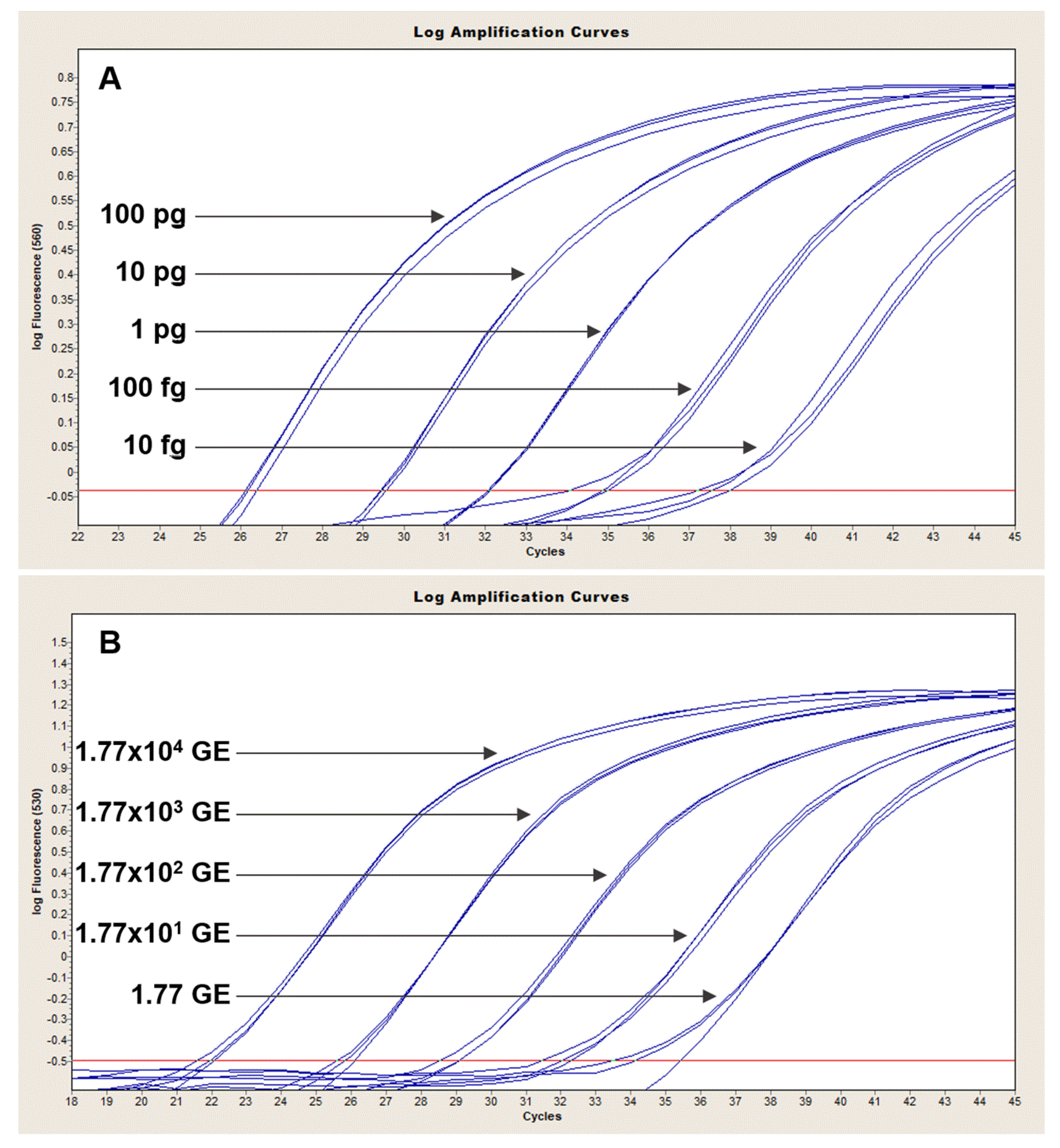
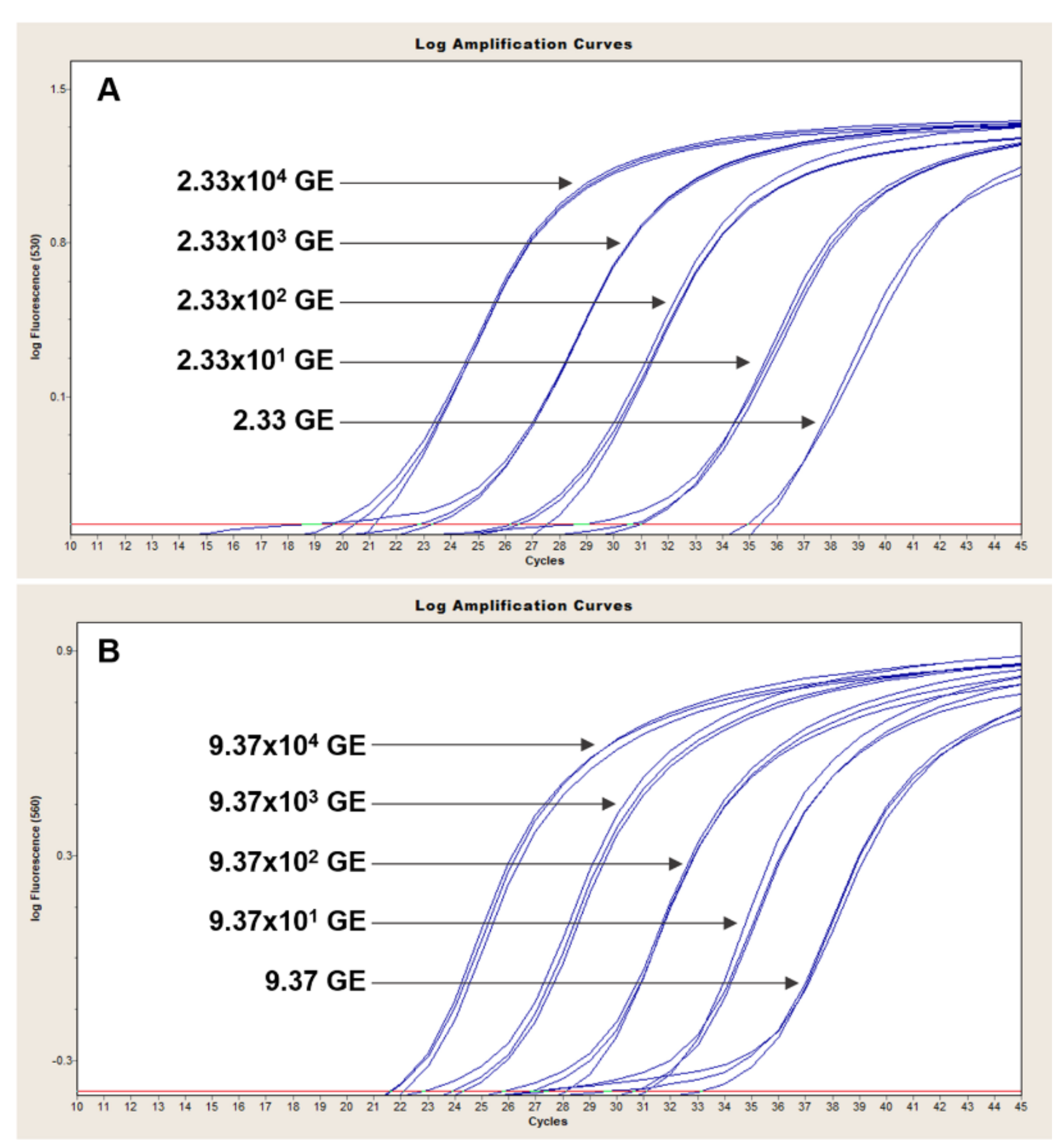
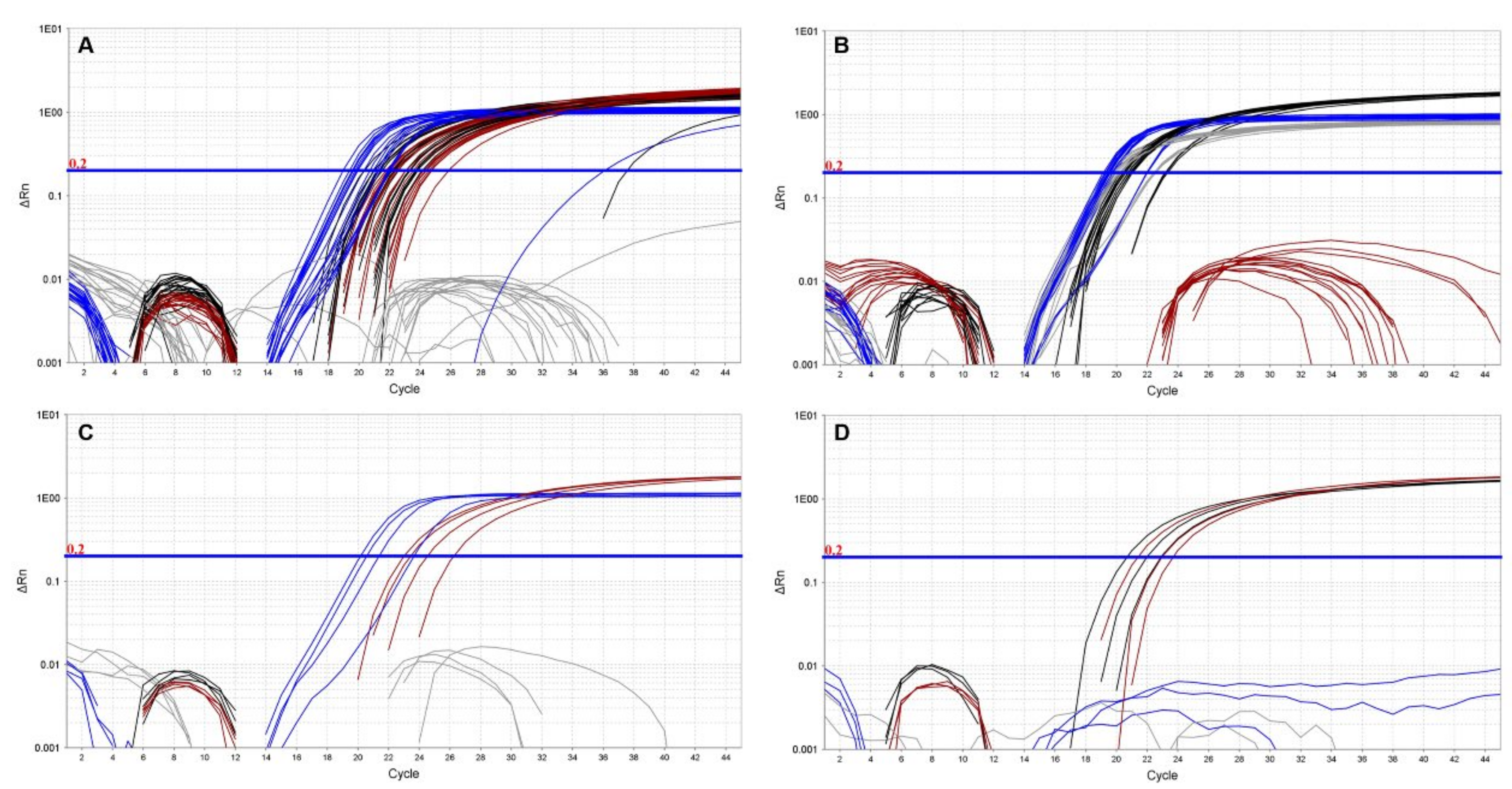
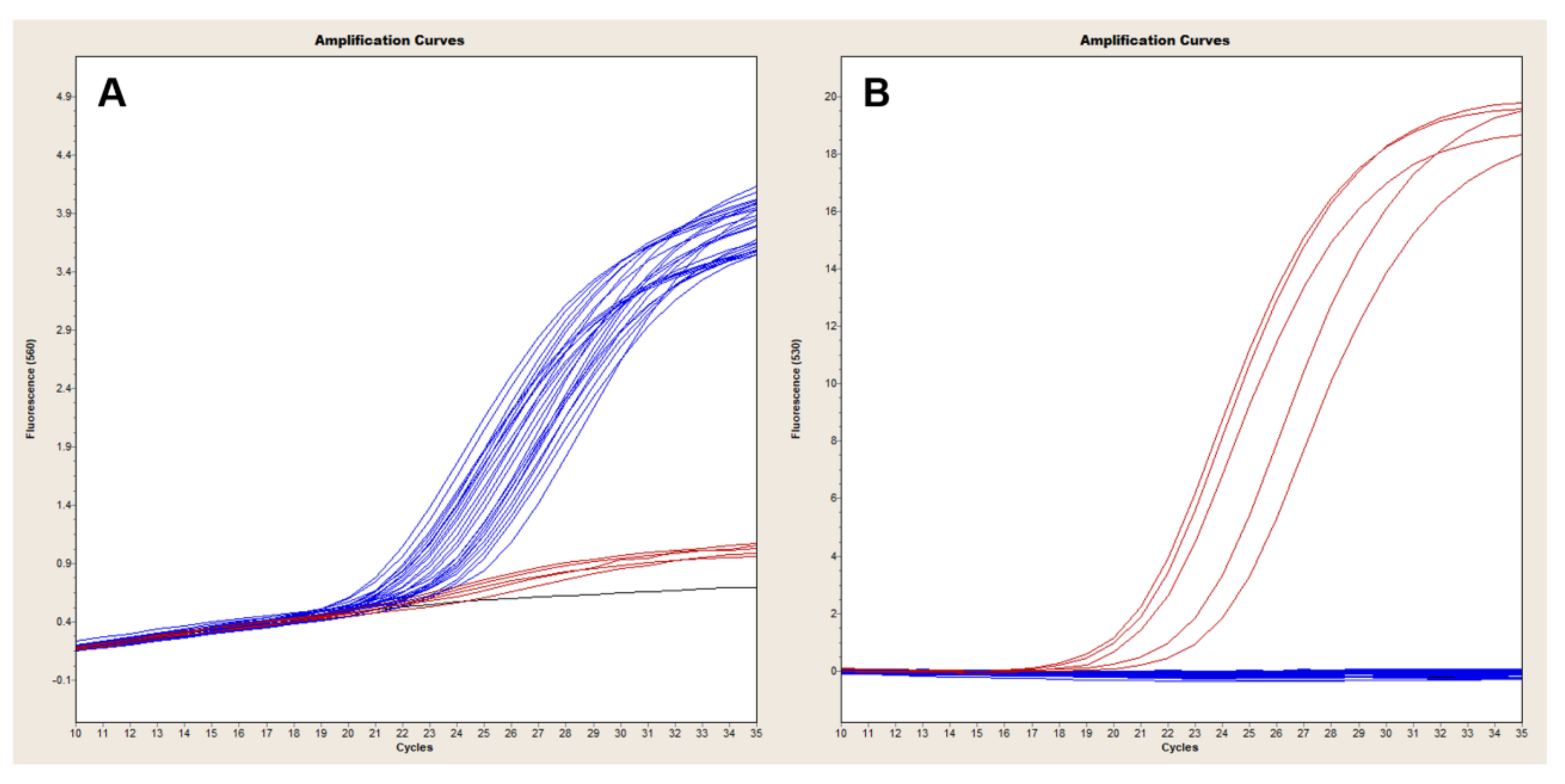
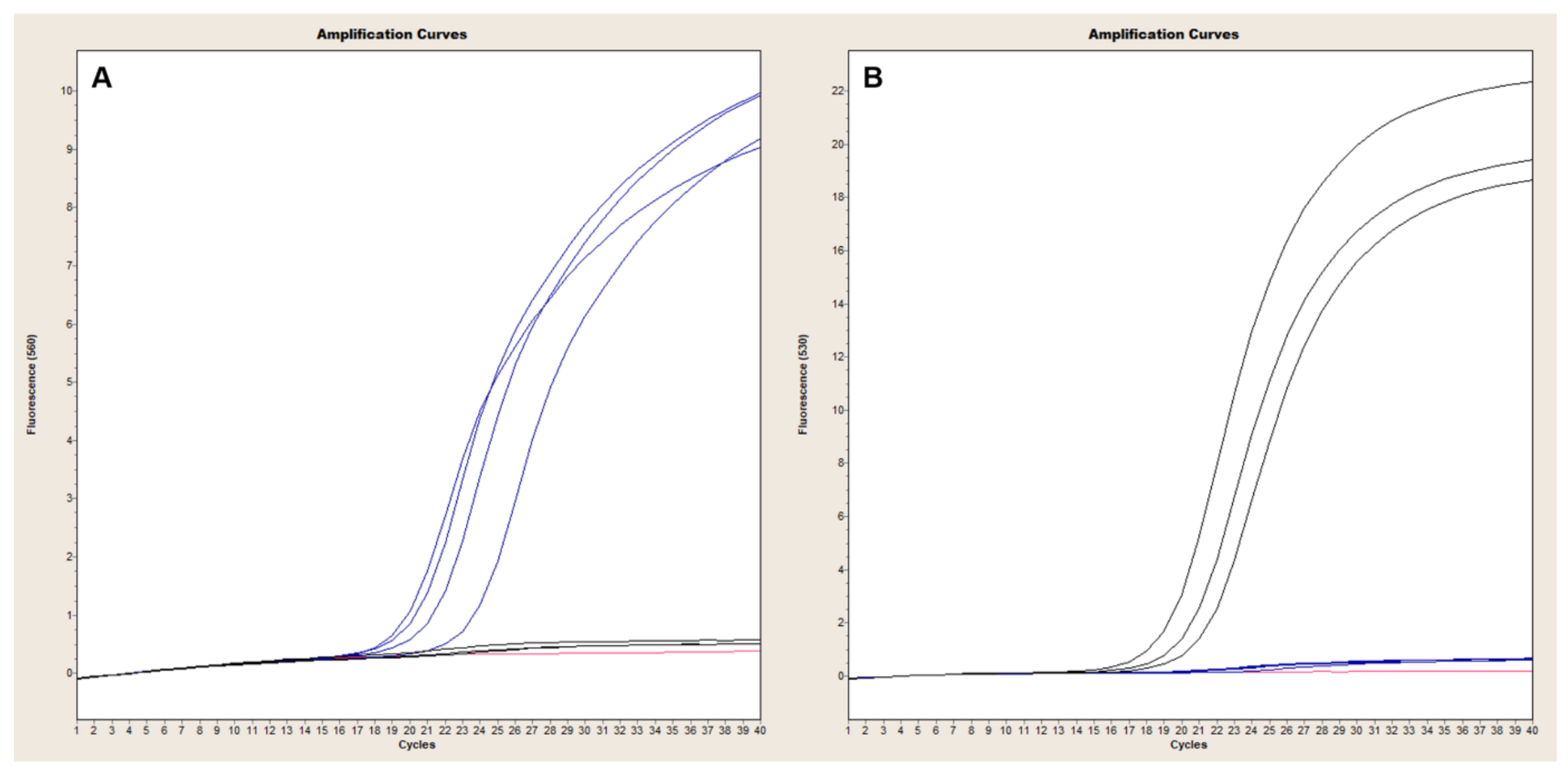
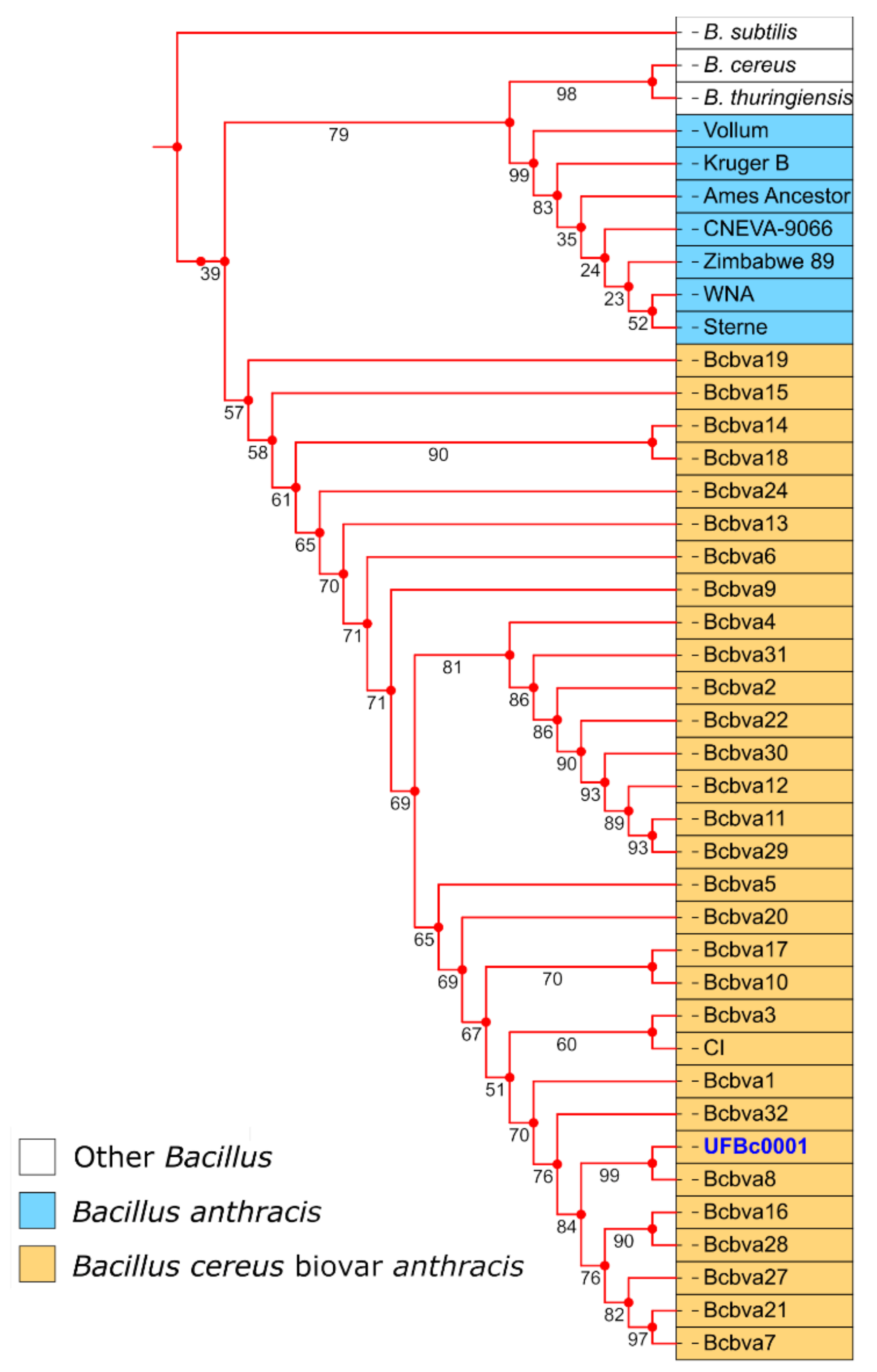
| A List/ Original ID | UF ID | Species | Strain | Lineage * | Strain Details |
|---|---|---|---|---|---|
| A0987 | UF00175 | B. anthracis | A.Br.005.006 | Botswana | |
| A0020 | UF00552 | B. anthracis | Ames | A3b | CAMR/Porton |
| A0537 | UF00965 | B. anthracis | A.Br.001/002 | China | |
| N/A | UF01137 | B. anthracis | WNA | A1.a, A.Br.WNA | Colorado, domestic cow, 2012 |
| A0897 | UF00727 | B. anthracis | A.Br.008/009 | Ethiopia | |
| A0389 | UF00930 | B. anthracis | A.Br.001/002 | Indonesia | |
| A0084 | UF00980 | B. anthracis | Vollum 1 | A4, A.Br.Vollum | South Africa |
| A2075 | UF01105 | B. anthracis | Ames | A.Br.005.006 | Tanzania |
| A0462 | UF00738 | B. anthracis | Ames | A3b | |
| A2017 | UF01114 | B. anthracis | Sterne | A.Br.001/002 | Texas, white-tailed deer, 2009 |
| A2076 | UF01106 | B. anthracis | Ames | A3b | Texas, white-tailed deer 2009 |
| A2006 | UF01096 | B. anthracis | Vollum | A4, A.Br.Vollum | Texas, white-tailed deer 2009 |
| A2064 | UF01063 | B. anthracis | WAG | Nigeria | |
| A2067 | UF01075 | B. anthracis | WAG | Nigeria | |
| UF01052 | B. anthracis | WAG | Nigeria | ||
| A0402 | UF00926 | B. anthracis | B.Br.CNEVA | France | |
| A0333 | UF00621 | B. anthracis | B.Br.CNEVA | Germany | |
| A0451 | UF00438 | B. anthracis | B.Br.001/002 | Mozambique | |
| A1088 | UF00910 | B. anthracis | B.Br.CNEVA | Poland | |
| A0104 | UF00839 | B. anthracis | B.Br.001/002 | South Africa | |
| A1055 | UF00603 | B. anthracis | C.Br.A1055 | USA | |
| A0530 | UF00878 | B. anthracis | A.Br.005/006 | Botswana | |
| A1202 | UF00049 | B. anthracis | Argentina | ||
| HHG80 | UF01135 | B. anthracis | Etosha Natl Park (ENP), Namibia | ||
| A1073 | UF00232 | B. anthracis | Chile | ||
| A1075 | UF00242 | B. anthracis | A.Br.003/004 | Chile | |
| Bc0001 | Bcbva | Côte d’Ivoire (Taï Natl Park) | |||
| Bc0002 | Bcbva | Côte d’Ivoire (Taï) | |||
| Bc0007 | Bcbva | Côte d’Ivoire (Taï) | |||
| Bc0009 | Bcbva | Côte d’Ivoire (Taï) | |||
| Bc0011 | Bcbva | Côte d’Ivoire (Taï) | |||
| B. cereus | FDA 5 | ||||
| B. cereus | Gibson 971 | ||||
| B. cereus | NRS 201 | ||||
| B. cereus | G9241 | ||||
| B. thuringiensis | Konkukian 97-27 | ||||
| B. thuringiensis | NRS 996 | ||||
| B. thuringiensis | AD-1 | ||||
| B. thuringiensis | HD-1 | ||||
| B. thuringiensis | Bt HD522 |
| Target | Oligo | Primer/Probe Sequence (5′–3′) | Final Concentration (nM) |
|---|---|---|---|
| Ba-1 | Forward | GTACATCTTCTAGCTGTTGCAA | 900 |
| Reverse | ACGTAGGAAGACCGTTGATTA | 900 | |
| Probe | VIC-CGTTGTTGTGTATTTG-MGB | 250 | |
| capB | Forward | TAAGCCTGCGTTCTTCGTAAATG | 600 |
| Reverse | GTTCCCAAATACGTAATGTTGATGAG | 600 | |
| Probe | NED-TTGCAGCGAATGAT-MGB | 300 | |
| lef | Forward | CACTATCAACACTGGAGCGATTCT | 600 |
| Reverse | AATTATGTCATCTTTCTTTGGCTCAA | 600 | |
| Probe | Cy5-AGCTGCAGATTCC-MGB | 250 | |
| GI4 | Forward | GGAGATATTAACAAGAGATGGATTGGA | 700 |
| Reverse | CAGTAGGCTTGTCTGCTCTAATAAAATT | 600 | |
| Probe | FAM-ACATGCCAGCGTTTTTTGCCTCTACACA-BHQ1 | 150 |
| Target | Oligo | Primer/Probe Sequence (5′–3′) | Final Concentration (nM) | |
|---|---|---|---|---|
| Duplex 1 | Ba-1 | F-primer | GTACATCTTCTAGCTGTTGCAA | 600 |
| R-primer | ACGTAGGAAGACCGTTGATTA | 600 | ||
| Probe | VIC-CGTTGTTGTGTATTTG-MGB | 250 | ||
| GI4 | F-primer | GGAGATATTAACAAGAGATGGATTGGA | 700 | |
| R-primer | CAGTAGGCTTGTCTGCTCTAATAAAATT | 600 | ||
| Probe | FAM-ACATGCCAGCGTTTTTTGCCTCTACACA-BHQ1 | 600 | ||
| Duplex 2 | lef | F-primer | CACTATCAACACTGGAGCGATTCT | 400 |
| R-primer | AATTATGTCATCTTTCTTTGGCTCAA | 400 | ||
| Probe | VIC-AGCTGCAGATTCC-MGB | 250 | ||
| capB | F-primer | TAAGCCTGCGTTCTTCGTAAATG | 600 | |
| R-primer | GTTCCCAAATACGTAATGTTGATGAG | 600 | ||
| Probe | FAM-TTGCAGCGAATGAT-MGB | 250 |
| LightCycler 2.0 | QuantStudio 7 | ||||||||
|---|---|---|---|---|---|---|---|---|---|
| Species | ID | Ba-1 | capB | lef | GI4 | Ba-1 | capB | lef | GI4 |
| Ba a Ames | UF00738 | 25.14 | 20.37 | 20.95 | Und. | 24.35 | 23.67 | 21.90 | Und. |
| Ba Vollum 1 | UF00980 | 24.69 | 32.12 | 32.45 | Und. | 25.85 | 37.52 | 36.08 | Und. |
| Ba Ames | UF01105 | 25.49 | 20.06 | 20.49 | Und. | 23.09 | 22.25 | 20.60 | Und. |
| Ba Ames | UF01106 | 26.17 | 20.46 | 20.89 | Und. | 24.69 | 23.73 | 21.92 | Und. |
| Ba Vollum (A4) | UF01096 | 25.36 | 20.68 | 20.73 | Und. | 24.55 | 23.84 | 21.83 | Und. |
| Ba WNA (A1.a) | UF01137 | 25.02 | 19.95 | 20.40 | Und. | 23.83 | 23.06 | 21.26 | Und. |
| Ba | UF00175 | 25.31 | 20.84 | 20.77 | Und. | 24.74 | 24.13 | 21.91 | Und. |
| Ba | UF01063 | 23.85 | 18.90 | 19.31 | Und. | 23.08 | 21.98 | 20.17 | Und. |
| Ba | UF01075 | 24.36 | 20.06 | 20.33 | Und. | 24.73 | 23.73 | 21.89 | Und. |
| Ba | UF01052 | 25.53 | 20.12 | 19.99 | Und. | 24.23 | 23.25 | 21.15 | Und. |
| Ba | UF00049 | 25.93 | 20.11 | 19.80 | Und. | 24.40 | 23.31 | 21.02 | Und. |
| Ba | UF01135 | 23.69 | 18.50 | 18.79 | Und. | 22.35 | 21.28 | 19.65 | Und. |
| Ba | UF00438 | 23.82 | 17.15 | 17.84 | Und. | 21.75 | 20.31 | 18.89 | Und. |
| Ba | UF00603 | 23.73 | 17.50 | 18.24 | Und. | 21.86 | 20.97 | 19.48 | Und. |
| Ba | UF00727 | 23.83 | 18.26 | 17.94 | Und. | 22.40 | 22.17 | 19.86 | Und. |
| Ba | UF00910 | 23.99 | 18.62 | 18.94 | Und. | 22.51 | 21.46 | 19.77 | Und. |
| Ba | UF00926 | 23.39 | 18.01 | 18.34 | Und. | 21.98 | 21.25 | 19.42 | Und. |
| Ba | UF00930 | 23.08 | 18.78 | 18.64 | Und. | 21.45 | 21.28 | 19.22 | Und. |
| Ba | UF00965 | 23.69 | 17.97 | 18.48 | Und. | 22.09 | 20.99 | 19.49 | Und. |
| Ba Sterne | UF01114 | 26.96 | Und. | 22.69 | Und. | 26.21 | Und. | 23.58 | Und. |
| Ba | UF00839 | 23.79 | Und. | 18.93 | Und. | 23.39 | Und. | 20.47 | Und. |
| Ba | UF00878 | 24.39 | Und. | 19.38 | Und. | 23.00 | Und. | 20.05 | Und. |
| Ba | UF00232 | 25.35 | Und. | 20.35 | Und. | 24.59 | Und. | 21.26 | Und. |
| Ba | UF00242 | 23.95 | 18.70 | Und. | Und. | 22.95 | 21.97 | Und. | Und. |
| Ba | UF00502 | 24.59 | 19.71 | Und. | Und. | 23.65 | 22.89 | Und. | Und. |
| Ba | UF00621 | 22.90 | 17.35 | Und. | Und. | 21.35 | 20.64 | Und. | Und. |
| Bcbva | Bc0001 | Und. | 19.33 | 20.01 | 21.22 | Und. | 20.75 | 19.50 | 20.16 |
| Bcbva | Bc0002 | Und. | 17.81 | 18.54 | 18.53 | Und. | 20.47 | 19.27 | 19.83 |
| Bcbva | Bc0007 | Und. | 17.56 | 18.39 | 17.60 | Und. | 20.36 | 19.12 | 19.56 |
| Bcbva | Bc0009 | Und. | 20.59 | 21.31 | 20.97 | Und. | 23.07 | 21.92 | 22.46 |
| Bcbva | Bc0011 | Und. | 17.91 | 18.74 | 18.90 | Und. | 20.92 | 19.77 | 20.14 |
| Bt b 97-27 | Und. | Und. | Und. | Und. | Und. | Und. | Und. | Und. | |
| Bt NRS 996 | Und. | Und. | Und. | Und. | Und. | Und. | Und. | Und. | |
| Bt AD-1 | Und. | Und. | Und. | Und. | Und. | Und. | Und. | Und. | |
| Bt HD-1 | Und. | Und. | 38.30 | Und. | Und. | Und. | 37.36 | Und. | |
| Bt HD522 | Und. | Und. | Und. | Und. | Und. | Und. | Und. | Und. | |
| Bc c FDA 5 | Und. | Und. | Und. | Und. | Und. | Und. | Und. | Und. | |
| Bc Gibson 971 | Und. | Und. | Und. | Und. | Und. | Und. | Und. | Und. | |
| Bc NRS 201 | Und. | Und. | Und. | Und. | Und. | Und. | Und. | Und. | |
| Bc G9241 | Und. | Und. | 20.12 | Und. | Und. | Und. | 16.22 | Und. | |
Publisher’s Note: MDPI stays neutral with regard to jurisdictional claims in published maps and institutional affiliations. |
© 2020 by the authors. Licensee MDPI, Basel, Switzerland. This article is an open access article distributed under the terms and conditions of the Creative Commons Attribution (CC BY) license (http://creativecommons.org/licenses/by/4.0/).
Share and Cite
Zincke, D.; Norris, M.H.; Cruz, O.; Kurmanov, B.; McGraw, W.S.; Daegling, D.J.; Krigbaum, J.; Hoang, T.T.H.; Khanipov, K.; Golovko, G.; et al. TaqMan Assays for Simultaneous Detection of Bacillus anthracis and Bacillus cereus biovar anthracis. Pathogens 2020, 9, 1074. https://doi.org/10.3390/pathogens9121074
Zincke D, Norris MH, Cruz O, Kurmanov B, McGraw WS, Daegling DJ, Krigbaum J, Hoang TTH, Khanipov K, Golovko G, et al. TaqMan Assays for Simultaneous Detection of Bacillus anthracis and Bacillus cereus biovar anthracis. Pathogens. 2020; 9(12):1074. https://doi.org/10.3390/pathogens9121074
Chicago/Turabian StyleZincke, Diansy, Michael H. Norris, Odalis Cruz, Berzhan Kurmanov, W. Scott McGraw, David J. Daegling, John Krigbaum, Thi Thu Ha Hoang, Kamil Khanipov, Georgiy Golovko, and et al. 2020. "TaqMan Assays for Simultaneous Detection of Bacillus anthracis and Bacillus cereus biovar anthracis" Pathogens 9, no. 12: 1074. https://doi.org/10.3390/pathogens9121074
APA StyleZincke, D., Norris, M. H., Cruz, O., Kurmanov, B., McGraw, W. S., Daegling, D. J., Krigbaum, J., Hoang, T. T. H., Khanipov, K., Golovko, G., Hadfield, T., & Blackburn, J. K. (2020). TaqMan Assays for Simultaneous Detection of Bacillus anthracis and Bacillus cereus biovar anthracis. Pathogens, 9(12), 1074. https://doi.org/10.3390/pathogens9121074





